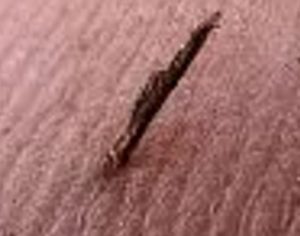 SCHAUMBURG, Ill. — Everyone has been there. No sooner did you or your child touch that old wooden bench when a small sliver of wood slides into the skin – causing a surprising amount of pain. Fortunately, say dermatologists, splinters are easy to remove with the proper tools and technique.
SCHAUMBURG, Ill. — Everyone has been there. No sooner did you or your child touch that old wooden bench when a small sliver of wood slides into the skin – causing a surprising amount of pain. Fortunately, say dermatologists, splinters are easy to remove with the proper tools and technique.
“Splinters come in all shapes and sizes, and they can really hurt,” said board-certified dermatologist Robert Sidbury, MD, MPH, FAAD, associate professor, department of pediatrics and division chief of dermatology, University of Washington School of Medicine. “To reduce pain and the possibility of an infection, splinters should be removed as quickly as possible.”
To remove a splinter, Dr. Sidbury recommends the following tips:
- Wash and dry the area: To prevent infection, wash your hands and the affected area with soap and water and gently pat your skin dry.
- Inspect the splinter: If the splinter is very small, use a magnifying glass to see how big it is and which direction it entered the skin.
- Use tweezers to remove the splinter: If part of the splinter is sticking out, you can use tweezers to gently pull out the splinter. First, sterilize the tip of the tweezers using rubbing alcohol. Then, pull out the splinter in the same direction that it entered the skin. Never squeeze out a splinter, as this may cause it to break into smaller pieces that are harder to remove.
- Use a small needle to remove the splinter: If the entire splinter is embedded under the skin, you can use a small needle to remove it. First, sterilize the needle and a pair of tweezers using rubbing alcohol. Afterwards, look through a magnifying glass and use the needle to gently pierce the surface of the skin at one end of the splinter. This may require help from a friend or family member. Continue to use the needle to carefully push out part of the splinter. Once one end of the splinter is sticking out, use the tweezers to gently pull out the splinter.
- Clean and apply petroleum jelly: After the splinter has been removed, clean the area with soap and water and apply petroleum jelly. Keep the area covered with a bandage until it heals.
“Most splinters can be safely removed at home, but some may require medical assistance,” said Dr. Sidbury. “See your doctor or a board-certified dermatologist if your splinter is very large, deep, located in or near your eye or if the area becomes infected.”
These tips are demonstrated in “How to Remove a Splinter,” a video posted to the AAD website and YouTube channel. This video is part of the AAD’s “Video of the Month” series, which offers tips people can use to properly care for their skin, hair and nails. A new video in the series posts to the AAD website and YouTube channel each month.
Source: American Academy of Dermatology [xyz-ihs snippet=”Adsense-responsive”]
